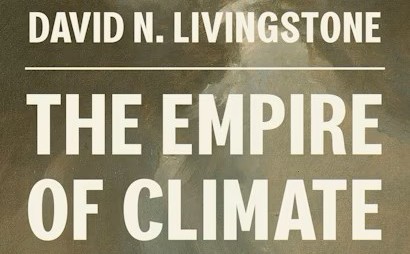The Journal of Historical Geography have newly published (June 2025) a ‘review forum’ based on David Livingstone’s recent book, ‘The Empire of Climate’. As well as myself, five other historical geographers — Awadhendra Sharan, Li Zhang, Louis S. Warren, Margarita Gascón, and Simon Naylor — also reviewed the book, and the journal has gathered these reviews together, along with Livingstone’s response to the reviews. My own review is very positive, although I paste below the final three paragraphs of what I wrote, which highlight a couple of minor criticisms:
“With much to praise in the book, I have just two small quibbles. The first is that Livingstone could, and perhaps should, have pressed home even more strongly the dangers of ‘climatic geography [being used to] choreograph humanity’s global drama’ (p. 5). There are dark forces lurking within climate’s empire, which Livingstone correctly labels as ‘the toxic topographies that need to be avoided’ (p. 402). These toxicities include climate’s role in the ‘reproduction of racial ideology, the justification of slavery, the rationalizing of conflict, the nurturing of eugenics, and the psychological and cultural stereotyping of major zones of the globe’ (p. 412). They extend to climatic apartheid (p. 193) and to zonal theories of history, wealth and culture (p. 403).
“But these are not just peculiarities of the past. A changing climate is being used today to justify forms of moral disciplining and social exclusion – using the tools of shaming, nudging, virtue signalling – and the old Platonic and neo-racist idea of uninhabitability and the torrid zone has returned under the rubric of the climate niche. As my colleagues and I have written recently, ‘climate threshold and eco-determinist claims often begin as part-imaginative scenarios, before being interpreted differently by others and coming to provide ready ammunition for incumbent economic and political interests.’
“My second observation is that for someone who wrote Putting Science in its Place: Geographies of Scientific Knowledge, Livingstone says surprisingly little about the geography that lies behind many of the scientific or pseudo-scientific claims which continue to serve climate’s empire. From where, by whom and for what purpose do these claims continue to emerge, with the alluring authority of science behind them? The parallel empire of climate science needs its own scrutinizing to weed out group-think, resist the temptation to succumb to the noble lie, and challenge the lazy and colonizing instinct which thinks that if it can be quantified then it can be climatised. When these claims serve the reductionist and reactionary forces of climate’s dark empire, it is important not to let them go unchallenged.”


